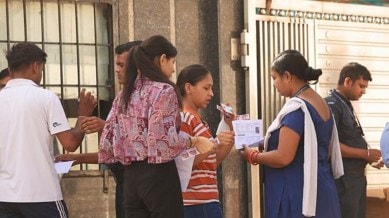This is how learning rates in Andhra Pradesh doubled
The Andhra Pradesh government had partnered with ConveGenius.AI, an AI-powered adaptive learning solution platform, to introduce their CG PAL in 2019 for students in Classes 6 to 9.

An evaluation study by researchers, including Nobel laureate and economist Michael Kremer, has found that a personalised learning software used in Andhra Pradesh’s government schools led to a doubling of learning rates among those who used it.
The Personalised Adaptive Learning (PAL) software — now used on tablets across over 1,200 schools in the state – determines a student’s learning level, and provides learning material and assessments like questions accordingly. By tailoring instruction to each student’s learning level, it is meant to address differences in learning levels and abilities within a class. The Andhra Pradesh government had partnered with ConveGenius.AI, an AI-powered adaptive learning solution platform, to introduce their CG PAL in 2019 for students in Classes 6 to 9.
In 2023, the Development Innovation Lab partnered with the Andhra Pradesh government’s Department of School Education and Central Square Foundation for a randomised control trial to evaluate PAL’s impact on math learning.
The PAL software was found to have increased the rate of learning for students by more than twice – their learning gains were around 2.3 times higher than students who did not use it. In terms of equivalent years of schooling, girls gained 2.31 years, while boys gained 1.54 years.
Students in the lower grades were also found to have gained more – students in Class 6 gained 2.04 years of schooling when they used the PAL software in the 2024-25, while students in classes 7-9, who used the software over two academic years, from 2023-25, saw gains ranging from 1.54 years of schooling (grade 9) to 2.36 years (grade 7). The figure for grade 8 was 1.77 years.
Presenting the findings in Delhi on September 8, Kremer, who is Director of the Development Innovation Lab, University of Chicago, said higher usage of the PAL software resulted in larger learning gains. While the average usage of PAL by students over the 17 months was 35.3 hours per student, the researchers found that an extra hour of usage per year is associated with 0.06 more equivalent years of schooling. Usage among students varied – those in smaller classes had better access to the tablets, and used the software more.
With higher usage leading to more learning, Kremer added that girls used the programme more than boys, and girls gained more from the programme than boys.
Going by details Kremer presented, the PAL software for math was supposed to replace two 40-minute math classes per week.
The Andhra Pradesh government provided tablets in these schools, and costs were covered from Samagra Shiksha funds, said B Srinivasa Rao, State Project Director, Samagra Shiksha, Andhra Pradesh. Teachers were trained to facilitate and monitor use of the software.
Rao said the state intends to scale up use of the PAL software to more schools, and is proposing to add it to PM-SHRI schools (there are over 900 in the state) and secondary schools. The plan is to procure Chromebooks for these schools, instead of tablets, anticipating that they might have a longer life, Rao said. He added that the tablets for PAL are used in labs in schools that have lab facilities, and are kept in the headmaster’s custody and brought into classrooms in schools that may not have separate labs.
While presenting the findings, Kremer said the underlying issue is heterogeneity in learning levels within schools. “Some students are excelling, but it’s also really easy for students to fall behind,” he said.
He also pointed to other research that has already been done on PAL, including work in 2019 that pointed to PAL having improved learning in Delhi private schools in after-school sessions, and in 2025 that showed that PAL improved learning in Rajasthan government schools.